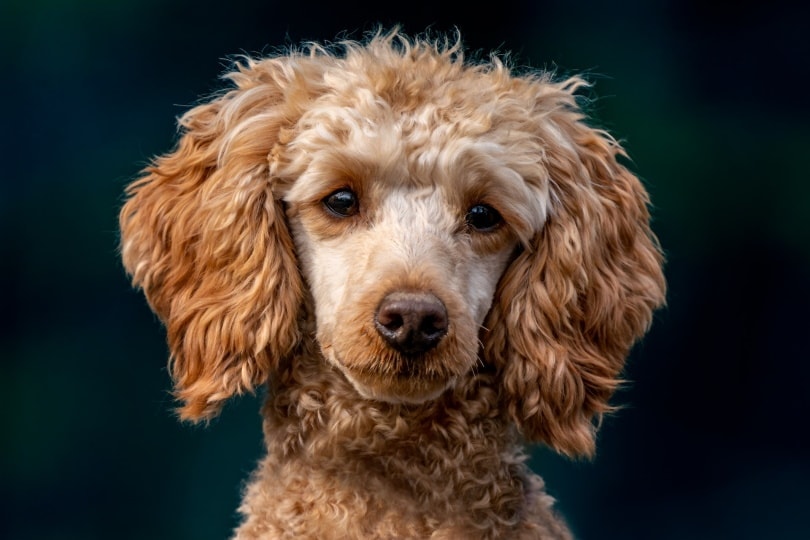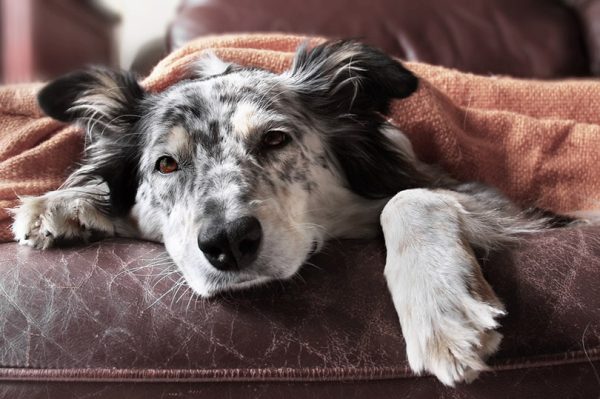Poodle lovers everywhere know that this popular dog breed has much going for it: intelligence, trainability, swimming ability, and a variety of coat colors. The standard coat colors of the Poodle range from white to red, to shades of gray and black, with the brindle coloring of the brindle Poodle being a rare coat color.
Breed Overview
Height:
15 – 24 inches
Weight:
40 – 70 pounds
Lifespan:
12 – 15 years
Colors:
Apricot, brown, white, gray, black, cream, fawn
Suitable for:
New dog owners, families with older kids, people with allergies
Temperament:
Intelligent, active, friendly, mischievous
Read on to learn more about the brindle Poodle, its ancestors, and the history of this hunting dog breed.
Poodle Characteristics

The Earliest Records of the Brindle Poodle in History
The brindle Poodle has an ancestry that can be traced to the curly-coated dogs of Asia, as well as the Barbet, a curly-coated dog of Russia and Hungary. The origin of the modern Poodle dates back to around 400 years ago in Germany, where it was known as the “pudelin”—which describes the dog’s natural swimming ability in the water. The standard Poodle was a favorite of duck hunters due to its curly coat protecting it from the elements, its swimming capabilities, high intelligence, and its excellent retrieving capabilities.
The Poodle was prized as a hunting dog for a practical reason: their coat served to protect the dog while still allowing them to have free movement in the water. Hunters would shave the neck, legs, and tail, but would leave the hips, leg joints, and chest coated to protect the dogs’ important anatomy from the cold.
How the Brindle Poodle Gained Popularity
The elegant look of the Standard and Miniature Poodles led many nobles in France to adopt the dog. Eventually, the dog become vogue in the rest of Europe. Poodles became popular on the European circus circuit because their intelligence, trainability, and looks made the dogs ideal entertainers.
During the early 20th century, the Toy Poodle was bred in America to become a small companion dog for people living in crowded cities. Whether the Poodle is a Standard, Miniature, or Toy, they’re all bred to exact standards and are close replicas regardless of size.
Formal Recognition of the Brindle Poodle
While the Standard Poodle, including the brindle Poodle, has been around for the last 400 years or so, it was only with the formalization of kennel clubs and Poodle societies in the last 150 years that the breed was formally recognized. The Kennel Club in Europe recognized the Poodle as a breed in 1874, soon after the club was formed. The American Kennel Club was founded in 1884 with the Poodle being recognized as a formal breed in 1886.
Interest in the Poodle breed steadily grew once the dog came to the United States, leading to The Poodle Club of America’s formation in 1931. A newer standard for the Poodle was approved by the American Kennel Club in 1932 with the Poodle Club of America holding the first specialty show that same year.

Top 3 Unique Facts About the Brindle Poodle
1. Brindle Poodles are Uncommon
The brindle coloring is an uncommon color. A brindle Poodle puppy will need two copies of the brindle gene (Kbr/Kbr), or one copy of the brindle gene and one copy of a non-dominant black gene (Kbr/ky). You’re more likely to find Poodles with the AKC standard colors, such as black, blue, apricot, brown, cream, café au lait, silver, silver beige, gray, red, and white.
2. The Brindle Coloring is Steadfast
The brindle Poodle’s coloring does not change as it grows older, unlike some other Poodle colors that fade in brightness as the dog ages. The dark and light stripes of the brindle Poodle should stay strong throughout its life.
3. Boy, the Prince’s Hunting Dog, Was Thought To Be a “Dog-Witch”
Boy, a white hunting Poodle, not a brindle, was gifted to Prince Rupert of the Rhine when he was imprisoned in Linz during the Thirty Years’ War (1618-1648). Boy was a loyal companion to Prince Rupert, and often rode into battle with his master during the English Civil War from 1642 to 1644. Boy was famous across Europe and was the subject of much propaganda, including the hearsay that he was a ‘dog-witch’, had demonic powers, could catch bullets in his mouth, and was invulnerable to attack. Boy died at the Battle of Marston Moor in 1644, when he chased after Rupert into battle and perished.

Does the Brindle Poodle Make a Good Pet?
A brindle Poodle will make a great pet for anyone looking to welcome a new dog into their home. All Poodles are loyal companions and are excellent pets for singles, couples, or large families looking for a loving dog. Poodles are intelligent dogs that enjoy training to learn not only basic obedience but more advanced training as well, such as agility.
Poodles are generally happy to be around their families but also tend to get along well with other pets in the household. Proper socialization is always needed to ensure that all the pets get along before leaving them alone together. Ducks and chickens should be kept in a safe area, as the Poodle was originally bred for hunting and has a high prey drive for birds.

In Conclusion
The brindle Poodle is a rare coloring of the popular Poodle that may be difficult to find at the breeders. It has a long history dating back to Germany around 400 years ago, when it was bred to assist duck hunters in capturing their prey.
With a long history of companionship throughout the years, the beautiful brindle Poodle maintains all the best traits of the Poodle, as it is loyal, intelligent, and makes a great family pet.
See also:
- Merle Poodle: Pictures, Info, Care & More
- Standard Poodle vs Goldendoodle: The Differences (With Pictures)
Featured Image Credit: Skyler Ewing, Pexels


















